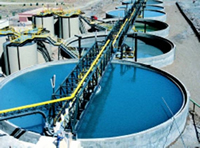
English
| 25/04/2024
|
| Home | Corporate Information | Business Lines | Ecological establishment seal | Present | Contact us | Legal info. |
Reduce your consumption up to 50%.
Adapt your consumption to your demand.
Less consumption. Less money.
More efficiency.
Reuse your water for
non-drinking purposes.
Quick information for
immediate decisions.
We assess your savings.
Prevention and control of Legionella.
BUSINESS LINES
WATER TREATMENT
|
Water treatment Methods | Water treatment process | Envioremental Impact
|
Water treatment Methods
Aeration
Aeration can be achieved allowing to water to leak across one or more perforated trays that contain small stones. The aeration increases the air content of the water, eliminates volatile substances as the sulphur of hydrogen, which concern the smell and the flavour, and oxidizes the iron and the manganese so that they form precipitates that could be eliminated by means of sedimentation or filtration. There are different methods for treatment of water that use simple technology and are low cost. These methods include sifted; aeration; storage and sedimentation; disinfection by means of boiling, chemical products, solar radiation and filtration; coagulation and floculation; and desalinización.
Coagulation and floculation
 If the water contains solid in suspension, the coagulation and the floculation can be in use to eliminate part
of the material. In the coagulation, one adds a substance to the water to change the behaviour of the particles
in suspension. It does so by allowing the particles, which previously were tending to repel some of others, to
attract others towards the added material. The coagulation happens during a rapid mixture or the process of
agitation that immediately continues by the addition of coagulant.
If the water contains solid in suspension, the coagulation and the floculation can be in use to eliminate part
of the material. In the coagulation, one adds a substance to the water to change the behaviour of the particles
in suspension. It does so by allowing the particles, which previously were tending to repel some of others, to
attract others towards the added material. The coagulation happens during a rapid mixture or the process of
agitation that immediately continues by the addition of coagulant.
The process of floculation that follows the coagulation consists of a soft and slow agitation. During the floculation,
the particles enter into contact, some join others to form major particles that can separate for sedimentation or
filtration. The sulfate of aluminium is a coagulant.
The factors that can promote the coagulation - floculation are the gradient of the speed, the time and the pH which is
a prominent factor in destabilizing action of the coagulating and flocculant substances.
Filtration
The filtration includes the absorption and the adsorption and, especially, in slow filters of sand, the biochemical processes. According to the size, the type, depth of the filter, the rate of flow and the physical characteristics of the water without treating, the filters can extract the solid in suspension, the pathogenic and certain chemical products. The sifted and sedimentation process are methods of treatment that precede the use of filtration to reduce the quantity of solid in suspension entering the phase of filtration. This increases the period in which the filter can operate before it needs cleaning and substitution. The coagulation and the floculation also are useful treatments before sedimentation and improve furthermore the elimination of solid before the filtration.
|
Water treatment Methods | Water treatment process | Envioremental Impact
|
| Home | Corporate Information | Business Lines | Ecological establishment seal | Present | Contact us | Legal info. |








